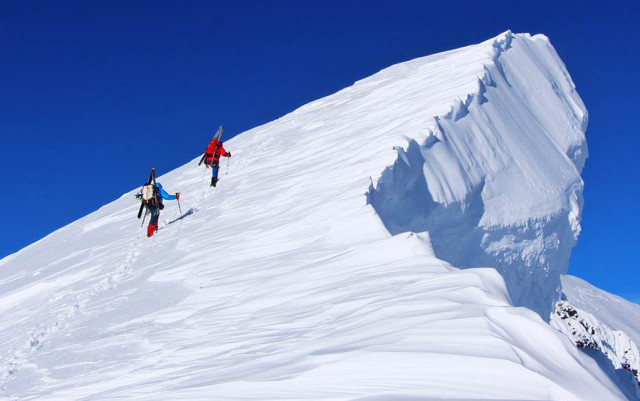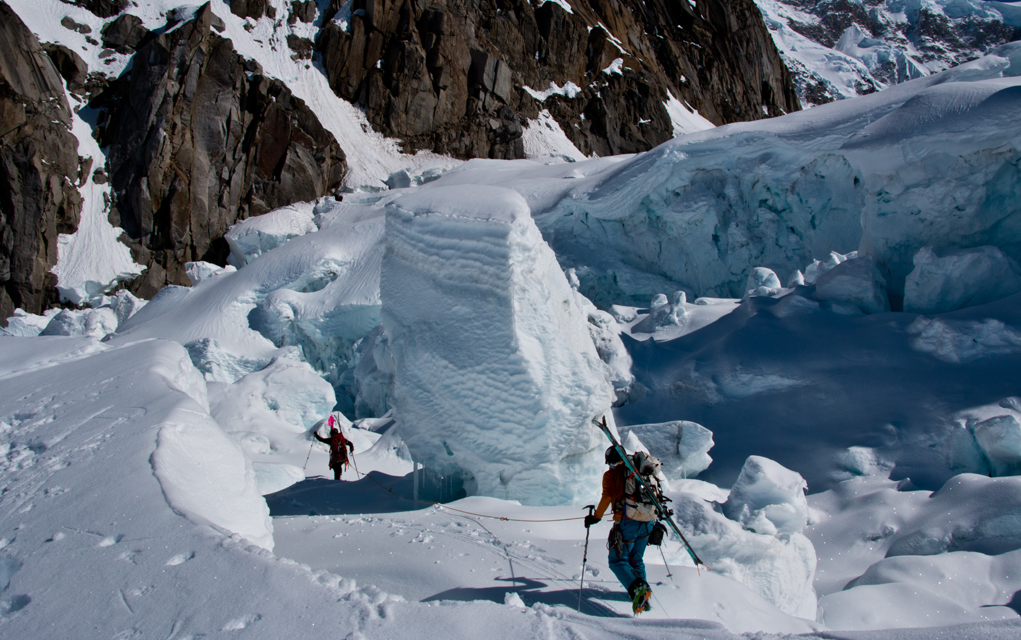
Skiing and climbing three of the most challenging mountains in the world while often withstanding temperatures below minus 30 degrees Fahrenheit, sky-tickling altitudes and winds that can blow climbers off the mountains may seem impossible to most people, but to the four men who did it in record time, they simply call it the month of May.
In May 2014, Evan Pletcher, Jordan White, Anton Sponar and Aaron Diamond climbed and skied all of Alaska’s “Big Three,” a mountain range that has three of the most challenging mountains in the U.S., in only 31 days. The team will give a presentation about their journey at Neptune Mountaineering in Boulder on Feb. 25.
The Big Three is comprised of Mount Hunter, Mount Foraker and Mount McKinley (also called Denali), the latter of which has the highest peak in the U.S. at 20,322 feet. The mountaineers estimated only a 5 percent chance of success for achieving their goal of being the first to summit all three mountains in one season.
“In a project like the Big Three, there are so many variables: weather, conditions, gear, our own skill level, etc.,” Diamond wrote in an email while on his way to a new adventure in Argentina. “We just guessed that the chance of them all lining up just right was slim to none.”
Although the men were all more than qualified for the journey, having all worked as either guides or mountain rescuers, preparations for their impressive goal were surprisingly minimal.
“My strategy could probably be described as ‘going in a bit clueless as to how much you’ve bitten off,’” Diamond wrote.
Their trip was sponsored by Dynafit, 40 Below, Liberty Skis, Folsom Skis, Oakley, Bern Helmets, Opensnow.com and Black Diamond. Lou Dawson and Wildsnow.com also supported them by editing and publishing blog posts that recount their remarkable trip.
Yet the team remains humble.
“I think for the most part, we aren’t really like the pro athlete type that you see,” Pletcher says. “We’re all the kind of guys who are just trying to make it in the mountains with goals, intense love and passion for big trips and big lines and just being out there.”
The journey began with the ascent of Mount Hunter, which stands at 14,573 feet. Although it is the shortest of the Big Three, it is arguably the most challenging because of its exceptionally steep faces.
“All of our summit days were [challenging] — I mean it was just a really incredible experience, each and every one of them,” Pletcher says. “And I’d say they were all really, really memorable. But our ascent of Mount Hunter was by far the hardest, which is kind of interesting because it was also 6,000 feet lower than Mount McKinley.”
Climbing 3,000 vertical feet in Colorado takes experienced climbers about an hour. Because of its steep and icy nature, ascending the steepest 3,000 vertical feet of Mount Hunter took the group approximately six hours.
“The route we took actually had never been navigated before. The other options were, you could say, less favorable,” Pletcher says. “One went under a really nasty icefall — the way an icefall works, it kind of can sheet off at any time and drop a bunch of unbelievably heavy, explosive and destructive blocks of ice down, which will either hit you or cause an avalanche that could kill you.”

Mount Hunter also presents the dangerous obstacle of blue ice — snow that has formed dense, blue-hued ice that fresh snow cannot stick to.
“I’d say when we all got to the top of Mount Hunter, it had been such an ordeal,” Pletcher says. “From our camp above the icefall, it took us 24 hours to get to the top of Mount Hunter, and that was a very powerful moment for all of us. It was the hardest climb I’d ever done.”
Completing Mount Hunter meant completing the hardest of the Big Three, which was already an accomplishment that only a small number of people in the world can say they have done. According to climbalaska.org, less than 40 percent of the few brave explorers who attempt to climb Mount Hunter succeed.
“It was probably the hardest physical challenge I’ve ever endured, and there were multiple times while we were up there where we really had to try, really to push ourselves to keep going,” Pletcher says. “We had great weather. It was a beautiful day up there. I think we all felt really accomplished. And I think if that had been the only thing that we were able to climb up, we would have still been really stoked on the trip.”
After successfully summiting Mount Hunter, the men moved on to brave the dangers of Mount Foraker.
“First, you have to climb this one mountain, and then you have to drop down and go on this ridge called the Sultana, which has in the past blown very experienced climbers and mountaineers off in severe weather just because of the way that it is positioned in the Alaska Range,” Pletcher says. “It kind of gets the brunt of all the bad weather, so people have been blown off of that before and never found.”
They packed six days worth of food for their journey up Mount Foraker and used a fast technique called alpine snow in a “make-it-or-break-it” attempt to avoid spending too much time on the dangerous Sultana Ridge.
“[Mount Foraker] had really great moments, but until I got off of that ridge, I don’t know if this goes for the other guys, I was uncomfortable because I knew what that ridge could do to us,” Pletcher says. “So, I was really relieved to get to the summit because it meant we could go home. We were really excited — we were that much closer to our goal.”
Completing Mount Foraker was a turning point on their expedition.
“When we had skied Hunter and Foraker,” Diamond wrote, “at that point we were determined to stick it out until Denali lined up.”
With two of the Big Three completed, the four men began climbing the tallest mountain in the U.S. At the 14,000-foot basecamp of Denali, they encountered groups of climbers who had been stuck camping there for three weeks, waiting for a weather window that would allow them to continue to the summit.

“We almost got shut down on Denali, which for us would have been a real disappointment,” Pletcher says. “And I mean, the climbing community would have probably also kind of laughed at us a little bit. And obviously they understand the weather up there, but after climbing two of the more difficult peaks certainly in the area, if not possibly in the world, and then going on Denali where there’s hundreds of people and wandered routes everywhere and extra food everywhere, it would have been silly.”
Denali presented the least amount of obstacles relative to the dangers of climbing Mount Hunter and Mount Foraker. However, Denali had the unique challenge of its immense altitude.
“Our summit day on Denali was slow, and we all had some degree of altitude ailment from that,” Pletcher says. “It was quite cold up there and just slow moving. We were pretty determined to get up there, but we also knew that our window was pretty short.”
Another factor that made Denali difficult for their expedition was the physical and mental exhaustion that the men had already been victim to from the first two mountains.
“Obviously, when we got to Denali and got to the summit there, we knew we could actually go home-home; that we’d actually, crazily, somehow accomplished our goal — that was pretty damn overwhelming,” Pletcher says. “That was probably the pinnacle, but I think Hunter was also right up there with it. The thing about being on Denali was that we were just, whether we knew it or not, we were all really physically and mentally exhausted at that point from the other things that we had gone through.”
Reaching their final summit and standing more than 20,000 feet high, the four men knew that the hardest part was over and that they had accomplished something that had not been achieved before.
“It was an extremely happy as well as emotional moment,” Diamond wrote. “I think most or all of us cried. We hugged. I’d guess it’s probably the happiest any of us have been while mildly hypoxic and freezing.”














